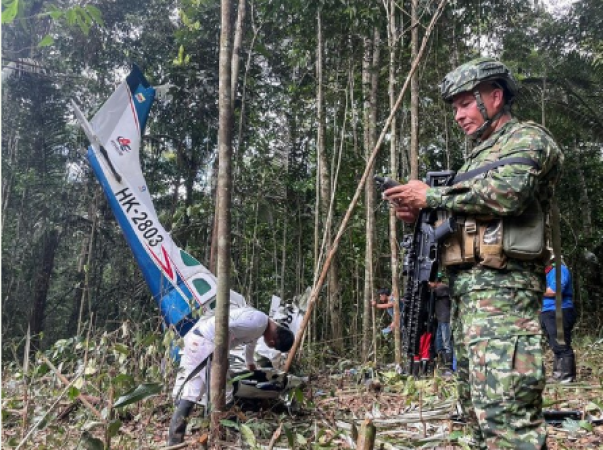
Bogota: The Colombian military declared Tuesday that it was "very close" to the four Indigenous children who have been wandering the Amazon since their plane crashed a month ago after finding a crude shelter, some half-eaten fruit, and a fresh footprint.
Since the light aircraft crash in southeast Colombia on May 1, which claimed the lives of the three adults on board—their mother Magdalena Mucutui Valencia, the pilot, and an Indigenous leader—the children, who are ages 13, nine, four, and one, have been lost in the jungle.
The bodies of the adults were discovered with the wreckage of the plane, but since then, 160 soldiers and 70 Indigenous people who are familiar with the jungle have been conducting a massive search for the children, including Lesly (13), Soleiny (9), Tien Noriel (4), and baby Cristin.
Also Read: Woman came alive after death, herself told the story after death
Rescuers discovered the most recent clues on Sunday, which "confirm two things: the first that they are alive, and the second that we are very close," team leader General Pedro Sanchez said on Blu Radio.
From an initial 320 square kilometres, or roughly twice the size of Washington, DC, the search area has been reduced to about 20 square kilometres (7.7 square miles), according to Sanchez. Given its size, the discovered footprint might belong to Lesly, who, according to relatives, is familiar with the jungle.
The new trail, in contrast to a sandal print discovered earlier, suggests that at least one of the kids is now barefoot. The team had discovered a pair of shoes and a nappy in the dense jungle the previous week.
Also Read: NATO aims to resolve disagreements regarding Ukraine's membership request
On Sunday, the team also discovered "a kind of resting place" or shelter close to the new print. The youngsters most likely used it for one or two nights, according to Sanchez.
We ran into the kids (at some point)," he continued.
Col. Fausto Avellaneda, a member of the search team, said the most recent discoveries "gives us new motivation and excitement."
In a video released by the military, he said, "This is a fresh footprint found about two kilometres from the last footprint we had found, and it gives us a sign that the children are still alive."
A Cessna 206 aircraft took off from Araracuara in the Araracuara jungle on May 1st, bound for San Jose del Guaviare in the Colombian Amazon.
The pilot reported engine problems shortly after taking off for the 350 km (217 miles), and the aircraft vanished from radars.
Soldiers discovered the three adult victims' bodies between May 15 and May 16, along with the plane's wreckage that was stuck vertically in dense vegetation and missing its nose.
10,000 flyers with instructions to stay put in Spanish and the children's own Indigenous language were later dropped into the forest by the air force.
The military has dropped food parcels and bottled water for the kids who are from the Huitoto community, known for coexisting peacefully with the jungle, and the leaflets also included survival advice.
Children in Huitoto learn how to hunt, fish, and gather, and according to the children's grandfather Fidencio Valencia, who spoke to AFP, they are familiar with the jungle.
In order for the soldiers to find the kids, rescuers have been broadcasting a message that was recorded by the kids' grandmother.
In a region where jaguars, pumas, snakes, and other predators live in addition to armed groups that smuggle drugs and terrorise local populations, the search is being conducted with the help of air force helicopters and satellite images.
Also Read: 26/11 Mumbai attack Hafiz Saeed's special terrorist Abdul Salam died in Pakistani jail
The children and their mother boarded the aircraft, according to Sanchez, to flee guerrilla activity in the area around their community. But he added that it was "unlikely" that any armed group had captured the children. "We have not discovered any prints of adults."
A "totally jungle terrain where you can see nothing 20 metres ahead, trees 40-50 metres (tall), where the Sun rays enter with great difficulty," according to Sanchez, made the search difficult.
He added that there was about 16 hours of rain per day, which obliterated any tracks and muffled the sound of movement.